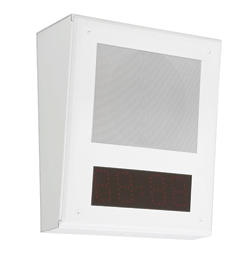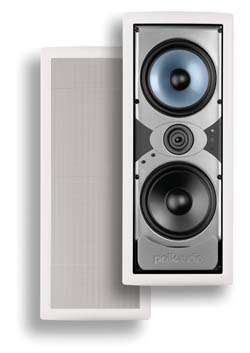- From the Pony Express to modern AV/IT convergence, the pain of change is still with us, and even though telegraph wires trumped horses, we don't hear much about Morse and his code these days.
Polk Audio's LC265i-IP
Take school intercoms as an example of change and convergence. Keyed switchbanks and patch cords gave way to Stroger switches, which gave way to electronic switching, which gave way to digital switching, which now appears to be giving way to IP switching and routing. Interestingly, the one school intercom system element that hasn't changed much over the course of other advances is the intercom speaker. Constant-voltage based distributed speakers have been in use since almost day one of the school intercom, and continue to be used daily. The reasons? Traditional intercom speakers are cheap, need power to perform their task, and work very reliably for a long time, without intervention or service.
Enter the IP-based speaker. Actually, enter IEEE standard 802.3 a/f, or power over Ethernet (PoE) embedded into a Layer-2/3 data switch, which opened the floodgate for the idea factories to begin pushing end-point devices that can be powered by standard data switches and then sent content over the same network infrastructure used by other network devices. This underscores case point number one for IP speakers; you can use a normal, properly configured PoE network port and the associated cable plant for speakers.
Real World IP Speaker Initiatives
Once the speaker power issue was addressed, and considering that power needed for the speaker is relative to required loudness output, the IP speaker had legs. Let's consider the following IP speaker initiatives that are either beginning to mainstream or at least creating a shadow on the horizon. And like both the Pony Express and telegraph wires, remember that without content and proper applicable attention to satisfying the user's real needs, any technology is not necessarily better than what came before.
Atlas Sound, a Mitek Corporation, has created and manufactured in conjunction with Berbee software, a VAR company in Minnesota, its first commercially available IP paging speaker. Utilizing PoE and other 802.3 Ethernet standards, the speaker has a built-in Network Interface Card (NIC) supplying the compliant network connectivity protocols. The Atlas I8S is a typical 8-inch speaker with an attached NIC daughter board, amplifier, etc.

Atlas Sound's I8SC
The reach and flexibility of an IP-based speaker, especially coupled with a centralized headend point and centralized management, make IP speakers inherently more flexible than traditional intercom speakers. Unification to a standard category cable plant and Ethernet-based switching, verses dedicated cable types and switching circuits, are strong justification for going with IP speakers, especially if simple relocation of devices without a lot of hassle or re-programming is desired. Even with the relatively high-price of a speaker, ROI calculations done for Cisco show that when all things are considered, IP speakers can be affordable. Nonetheless, the Cisco front-end application for driving the Atlas speakers is limited in features when compared to other mainstream legacy intercom solutions. Even with the added benefits of IP-enabled features, like remote adjustment of individual speaker levels via the software, one needs to clearly understand not just what the software can do with the speaker, but more importantly, what it can't. As more software becomes available and the market matures, these limitations will go away, just like with early VoIP systems. Atlas is leveraging its current strength in intercom speakers, backboxes, and grilles, while also offering an IP-based digital clock assembly that mates seamlessly to the IP speaker to form a complete classroom voice-clock IP endpoint.
Valcom Corporation of Roanoke, VA, offers its IPSolutions family of IP gateways and its VIP-402 IP speaker ceiling speaker. The gateways offer transition from traditional paging circuits to IP switching and back for a variety of applications including long-haul paging across LANs and WANs and pure IP speaker paging/talkback. Features of the Valcom approach are predicated on the abilities of traditional front ends like telephone systems or microphones, while leveraging the reach and flexibility of the network.
Digital Acoustics, of Lake Forest, IL offers its ii3 IP speaker series and Talkmaster software. Like Cisco and Berbee, they are targeting the school intercom market as well as corporate and industrial paging and have written OEM applications for a list of notable companies, including HP and IBM.
Many other players are entering the field, which is to be expected as IP speakers get traction and establish success stories. In the consumer channel, Polk Audio has teamed up with D2 Audio and NetStreams to create its LC265i-IP, IP-based self-amplified consumer loudspeaker. The 265i-IP requires a wall-wart type of power supply, but beyond that limitation appears to be a complete solution for keeping the content and the delivery technology packet-based and residing on the network.
